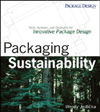As you may have read in World Bioplastics, a November 2013 industry study conducted by The Freedonia Group, the global demand for biobased or biodegradable plastics will rise 19 percent to 950,000 metric tons in 2017.
The most rapid growth is forecasted for biobased commodity resins, such as polyethylene and polypropylene, for plastic bags and other packaging.
By all accounts, this is great news. Not only does it show that our industry is responding to consumer demands, considering the environment in how we operate, but it also demonstrates a willingness to innovate.
I believe the latter is key.
Certainly, biobased or biodegradable packaging reduces our use of non-renewable resources, but sustainability-driven innovation is about more than just feeling good about our corporate citizenship. It’s also about making business operations and processes more efficient, differentiating product offerings, and identifying opportunities and risks to increase revenue, margins and brand value.
In their Deloitte article, Sustainability 2.0: Using sustainability to drive business innovation and growth, Peter Capozucca and William Sarni say that sustainability fuels innovation by introducing new design constraints that shape how key resources are used in products and processes.
|
Quick Definitions
Bioplastics: plastic that is biodegradable, has biobased content, or both.
Biodegradable Plastic: a plastic that undergoes biodegradation (a process in which the degradation results from the action of naturally-occurring micro-organisms such as bacteria, fungi, and algae) as per accepted industry standards. As of 2008, accepted industry standard specifications are: ASTM D6400, ASTM D6868, ASTM D7081 or EN 13432.
Biobased content: Fraction of the carbon content, which is new carbon content made up of biological materials or agricultural resources versus fossil carbon content. Biobased content is measured following the procedures set by ASTM D6866.
Source: the SPI Bioplastics Council
|
They write: “[Energy, carbon, water, materials and waste] are ubiquitous throughout an organization’s supply chain, and the potential to boost efficiency and cut costs across these resources is significant. In the past, they often were not treated as primary design constraints. That’s now changing, and how a company attempts to overcome these new design constraints, delivering similar levels of performance and cost at lower levels of resource usage, may be key to its prospects.”
Take, for example, a case study from the plastic packaging manufacturer I work for. One of our customers, a produce distributer, was using 0.6-mil shrink film to wrap cucumbers, just above the industry standard. By looking at their film packaging through a sustainability lens—wanting to reduce waste and use less material—we worked with our resin suppliers to engineer a film that was a 25% reduction in gauge: 0.45 mils, our lowest yet. More impressively, the resulting film performed even better than the original. We developed a glossier, thinner and stronger film that ran on the line with reduced tail length to give the producer growers more cucumbers per pound of film.
Without new design constraints, our customer might still be using the thicker, more expensive, and less sustainable shrink film.
Opportunities to innovate are everywhere. Flexible packagers simply need to rethink their product offerings or manufacturing processes from a sustainability vantage point.
I don’t believe that every packaging application needs to include biobased or biodegradable materials to be more sustainable. The downgauged cucumber shrink film I just mentioned was not a compostable or biodegradable product.
Having said that, there are endless opportunities to innovate using bioplastics. The technology already exists and it is improving constantly. BASF, for example, makes a high-performance resin called Ecovio, which combines biodegradable and compostable petrochemicals and a starch-based polylactic acid (PLA). These resins blend easily into multilayered film packaging.
Not limited to organic waste bags or shopping bags, some of the more interesting applications we have engineered with these biobased resins include mulch film, shrink film, compostable fruit stickers, compostable courier bags and compostable K-Cup coffee lidding stock.
What are we waiting for?
For the flexible packager, sustainability-driven innovation awaits. All you need is the right idea and a plan.
To help get your thinking process started, here are a few guidelines.
- Look at your supply chain for sustainability opportunities and risks
- Research standards compliance
- for opportunities
- Investigate the sustainability priorities of your key
- customers and competitors
- Look for issues where high financial impact aligns with high sustainability priority
- Think current, but also leave room for future opportunities
If you’re still struggling with sustainability-driven innovation, it might be time to collaborate with a film-manufacturing partner that has its own commitment to R&D.
Be sure to look for a film supplier that is constantly working with their resin developers, testing new formulations and customizing film solutions for different applications. This kind of partner should be able to work with you to discuss film characteristics and how you can reduce thickness, optimize materials, improve line efficiencies and more.
Your company is looking to innovate, so avoid a film supplier that only offers à la carte products and pricing. Instead, find a film partner who is willing to create an innovative solution for your packaging challenge.
It is an exciting time for the flexible packaging industry, and a focus on innovation will only make us more competitive, more profitable, more able to reduce risk or withstand its effects and, most importantly, more sustainable.






